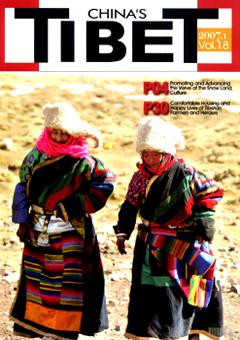ART ON SEALS IN ANCIENT TIBET
ZHOU XICHENG
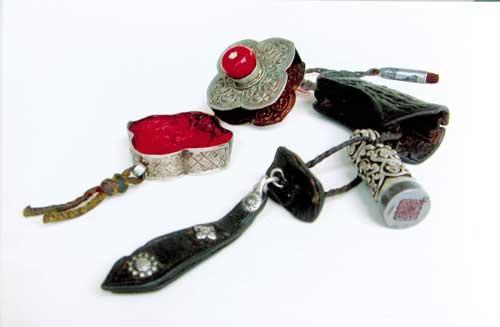
A set of seal used by eminent monks, inlaid with red corals on the seal box.
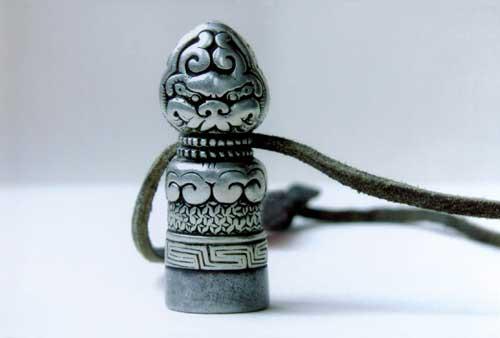
Archaic seal of cyan brass shaped as dagoba.

Seal with Ruyi decoration used by eminent monks and engraved with double-faced golden birds.
Tibetan archaic seals have been a significant element of Tibetan art and civilization for over 2000 years, embodying the rich, historic Tibetan culture.
I have been extremely fond of Chinese seals since I was a little kid. When I first encountered Tibetan seals in 1985, I was both astonished and attracted. For over 20 years now, I have been living in Tibet and dedicating much of my time to study the calligraphy, motifs, and buttons of Tibetan seals. I am on a long journey of studiously collecting, cataloging, and studying the arts of Tibetan seals by traveling all over Tibet and the Tibetan inhabited areas in Qinghai, Ganshu, Sichuan, and Yunan. In monasteries, I learnt from lamas, and I was extremely impressed with Tibetan Buddhism, which I found so broad and profound. In nomadic areas, I lived with herdsmen and studied Tibetan language. I even learnt to sing Tibetan songs. When traveling by foot, I often sought Tibetans' generous assistance. Some of my collected seals were freely donated by them. I frequently exchanged my views on Tibetan studies with scholars, and was also acknowledged and supported.
In the history of Chinese seals, those in Tibet are fascinating treasures. They reveal a profound and broad history, the personality, political climate and religion of Tibet. The calligraphy, motifs, and materials of seals are designed and arranged in various ways, which cannot be compared to any other ethnic group. The seals are not only a testimony of history and a symbol of power, but also the comprehensive embodiment of a multitude of arts. Once a seal is held in one's hand, its power is guaranteed. This applies not only in the secular world, but is also in the sacred. Persons holding a seal in the secular world are rulers of certain areas, so too religious leaders always hold their own seals. Old Tibet ran on a system that combined politics and religion. Thus, the seal became extremely important. Persons holding a seal would have power to control both politics and religion in Tibet, but must follow the law and regulations of the central government. One holding a seal must also follow what Emperors of the central governments asked him to do and take responsibility for administration of both local secular and clerical affairs.
In 1996, I went to the Tibetan inhabited area in Sichuan Province. I accidentally obtained a gold and brass, silver plated double-faced seal. It was later identified as the seal of Minyak Monastery, which belonged to the Sagya Sect.
The double-faced seal is 7.2 cm in height, round in shape and with a 3.0 cm diameter; the square face is 3.0 x 3.0 cm. It is engraved with Tibetan calligraphy, meaning "once see, you will receive blessing from Minyak Monastery". Circular lines are engraved at the bottom of the seal's key words that evolved from the Lei lines, which were quite popular calligraphy in archaic porcelain and bronze articles. The lines look like the Chinese character of "Hui (circle)", interpreted as propitious and signifying longevity. The other side has another round shaped seal, engravings with the sun and moon at the top, together with Tibetan letters that are an abbreviation of Minyak Monastery.
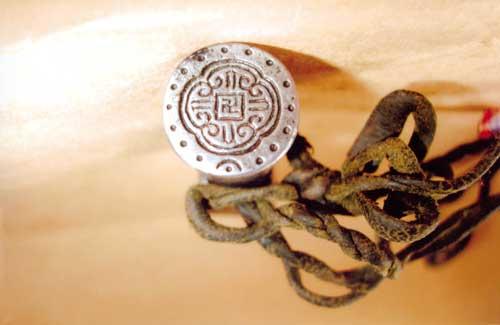
Double-faced seal used by Lhagyari ruling Lama in Lhoka,round in shape and made by silver and iron.
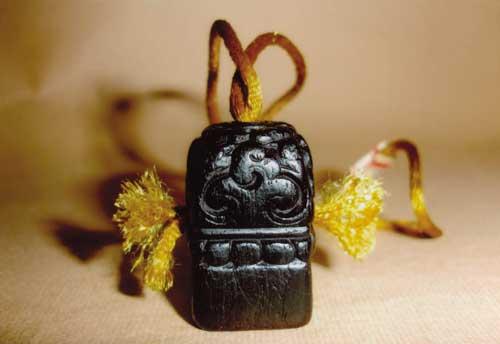
Rosewood used by eminent monks.
Minyak Monastery is situated 113 kilometers from the northwest of Kangding in Sichuan Province and is 3730 meters above sea level. This is one of the most well-known monasteries belonging to Sagya Sect, with a history of over 1000 years it is also referred to as the "small Jokhang Monastery"; a holy place for Kham Tibetans in pilgrimage.
Minyak Monastery was built at the middle of the Seventh Century. As the story goes, in 641 A.D, Emperor Tang Taizhong betrothed Princess Wenchen to King Songtsen Gampo and bestowed a 12 year-old Shakyamani Statue to King Songtsen Gampo and Princess Wenchen. However, while Princess Wenchen passed through the Minyak Monastery, something strange occurred. The statue seemed to be rooted on the ground and became impossible to move. While people tried to move the statue, the Buddha started to speak and said he preferred to stay put. However, it was essential that the statue go to Lhasa. So, Princess Wenchen decided to ask people to make a copy by taking the local gold sand and placed it in Minyak Monastery. It is said that, once the bottom half of the body was built up, the upper body was automatically formed overnight. After the duplicate was built, the original statue could be moved again. Finally the original statue arrived at Lhasa and was preserved in Jokhang Monastery.
After the Princess arrived at Lhasa, King Songtsen Gampo built 108 temples. The entrances of all temples were faced towards the monasteries in the hinterland. Minyak Monastery was the one of most ingenious and the last to be built. Many years later, a monk came from India. He subdued the local devil that was opposing the power of Buddha, and then he held a grand ceremony for the monastery. The success of the ceremony made all Buddhas appear in their true figures. People were astonished and shouted "Minyak and Minyak" (In Tibetan, it refers to happiness of Buddha and Bodhisattva). Since then, Minyak has become the name of the monastery.
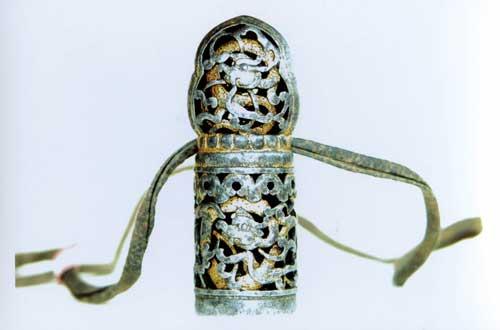
Silver seal used by Tibetan autocrats.
The Shakyamani statue is located in Minyak Monastery, stacked with thousands of gold and silver articles, gems and other treasures presented by pilgrims. In the monastery, the footprint of a whiz kid is preserved on a stone 2310 by Phagpa, a state preceptor in the Yuan Dynasty. A statue of the Buddha of Mercy with thousands of hands, one meter in height is also kept inside, and other rare treasures and religious relics are persevered within as well. For example; relics of Buddha Gyayiku, the bell used by a famous Indian clergy in the 11th Century, seals, a gold-plated brass Buddha statue given by Phagpa to Minyak Monastery and the walking stick of Hongcham Gara (a well-known Indian monk).
The seal mentioned above can be dated back to the Ming Dynasty, about 500 years ago. Its detailed art and design is absolutely wonderful. The handles on both sides have a dent, indicating that the seal was used frequently.
There is another Tibetan double-faced seal inlaid with gold and silver, which was a seal of King Lhagyali. The engraved motifs present on both sides are very special. On one side, a Yongdrung motif (referring to the reversed fylfot (swastika)) is carved on the middle of the face. The fylfot has same meaning as the motif of Taiji and refers to wheel of Yin and Yang. Besides the Yongdrung motif, four wheels are engraved on it, which refer to the wheels of law which continue turning forever to disseminate the law of Buddhism. The motif of Yongdrung is engraved in a Tibetan way, as the fylfot, which is the representative sign of the law of Buddhism. The border of wheels is carved with 16 treasure symbols. The top of the face of the square seal is engraved with linear patterns of the sun and moon. Four non-inverted wheels are carved on each of the four corners of the square seal. On the face, archaic letters of Phagpa are engraved, which mean "I - the King of Lhagyali".
According to the historic records of Tibetan literature, the Lhagyali was the descendant of the Osong, the son of Langdamor (One of the Kings in Tubo). He was conferred as Trichen, a title that refers to having power to control both political and religious affairs. He held these powers, conferring him King of Lhokha Jokod. Around the 12th Century, its inhabitants founded the royal system of Yarlung Jokod upon Lhokha-controlled land. Soon, the royal system of Yarlung Jokod, called as Lhagyari, built the Rugo Qude Monastery, also referred to as Gyali Monastery. In Tibetan, the word "Lhag" means "deity". The descendants the royal family commonly adopt the word of "Lhag". The family combined their power with the power from monasteries and became King of the region by holding both political and religious power. Later, the second, the third, and the fifth Dailai Lama visited this family. After Gelu Sect controlled the regime of Tibet, the fifth Dalai Lama conferred the title of Trichen on the Lhagyri family as ruler, to control both politics and religion.

Seal bestowed to Tibetan eminent monks at the beginning of Qing Dynasty.
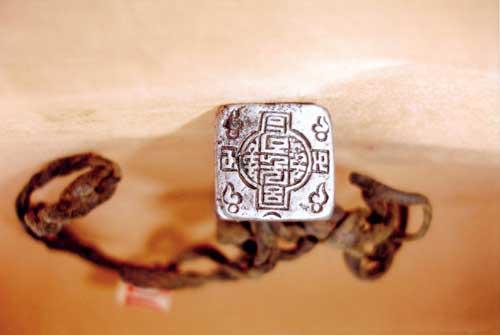
Seal in square face used by Lhagyari ruling Lama and engraved with Phagpa characters at the middle
but Tibetan at the right and left side and conch at the four corners.
As the descendants of King Tubo and rulers of Lhokha, the Lhagyri family enjoyed ceremonial privileges in the local Tibetan government. Once Trichen made a pilgrimage to Lhasa, Gasha Government sent Tsezun and Xogdzun Gain (both etiquette officers) to greet them at the side of Lhasa River. While meeting the Dalai Lama, in public, the Trichen could only raise their body slightly, but did not have to kneel down. When the Trichen was enthroned or married, the Gashan Government must send officers from the fourth guard to convey their congratulations. Trichen had authority over administrative and judicial matters in its own territory, and could dismiss any officer without the consultation of others. Throughout history during each Dalai Lamas enthronement ceremony, King Lhagyri would wear an archaic garment of King Songtsen Gampo and would go to Lhasa to pray and offer congratulations.
Tibetan seals embody creative thinking through both a general engraving style and linear patterns. The seals are often decorated in an impressive manner. Fortunately, a hundred years have already passed and the seal I mentioned above still keeps the inside of its original deer ribbon. Texture research has shown the seal to be about 400 years old.
From my experience in collecting and studying Tibetan seals, I am profoundly impressed with the richness of the splendid ethnic Tibetan culture. A seal is so small in size but displays the evolution of Tibetan characters, the unique technology of metal smelting, exquisite engraving arts, the changes of religious culture and the advance and development of Tibetan society. It is an agglomerated history of Tibet.

